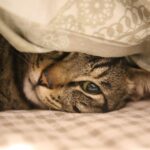Cats are often regarded as family members, and as pet owners, we bear the responsibility of ensuring their safety and well-being. One of the most pressing concerns for cat owners is protecting their feline friends from household toxins. Many common household items can pose serious threats to cats, from cleaning products to certain plants. In this article, we’ll explore various ways to keep your cat safe from these hazards, providing valuable information to help you maintain a safe and healthy environment.
Understanding Household Toxins and Their Effects on Cats
Before diving into prevention tips, it’s essential to understand what household toxins are and how they can affect your cat. Household toxins can be anything from chemicals found in cleaning supplies to common foods that are harmless to humans but harmful to cats.
Common Household Toxins
Cleaning Supplies: Many cleaning products contain harmful chemicals like bleach, ammonia, and phenols. Ingesting or inhaling these substances can cause respiratory distress, gastrointestinal issues, and neurological problems in cats.
Essential Oils: While they may smell wonderful to humans, essential oils such as tea tree oil, eucalyptus, and lavender can be toxic to cats, potentially leading to liver damage or respiratory issues.
Plants: Several common household plants are toxic to cats. These include lilies, philodendrons, and azaleas, which can cause symptoms ranging from vomiting to organ failure.
Food: Many foods that are safe for human consumption can be dangerous for cats. Common culprits include onions, garlic, chocolate, grapes, and raisins.
Medications: Over-the-counter or prescription medications that are safe for humans can be lethal to cats. Pain relievers like ibuprofen and acetaminophen are particularly dangerous.
Pesticides and Insecticides: Products designed to kill pests can be harmful or even fatal to cats if ingested or absorbed through the skin.
Batteries and Electrical Cords: Though not toxins in the traditional sense, ingesting batteries or chewing on electrical cords poses serious physical dangers, including chemical burns and electrocution.
Signs of Toxic Exposure in Cats
Recognizing the signs of toxic exposure in your cat is crucial for timely intervention. Symptoms may vary depending on the substance involved but can include:
- Vomiting
- Diarrhea
- Lethargy
- Excessive drooling
- Seizures
- Difficulty breathing
- Loss of appetite
If you suspect your cat has been exposed to a toxic substance, it’s vital to contact your veterinarian or an emergency animal poison control hotline immediately.
Creating a Safe Home Environment for Your Cat
One of the most effective ways to protect your cat from toxins is to create a cat-safe environment. Here are several steps you can take to minimize risks:
1. Proper Storage of Chemicals
Keep cleaning supplies out of reach: Store cleaning products in high cabinets or locked storage areas, away from your cat’s reach. Consider using pet-safe cleaning products that reduce the risk of toxicity.
Read labels: Always carefully read the labels of products you bring into your home. Look for statements about pet safety or non-toxic ingredients.
2. Choose Cat-Friendly Plants
Research your plants: Before bringing a plant into your home, research its safety for pets. Opt for non-toxic options like spider plants, Boston ferns, and cat grass.
Place plants strategically: If you have toxic plants, keep them out of reach or in areas that your cat cannot access, such as high shelves or hanging planters.
3. Safe Food Practices
Educate yourself on safe foods: Familiarize yourself with foods that are toxic to cats and avoid feeding them anything that’s unsafe.
Secure kitchen areas: Always keep food items like grapes, chocolate, and onions stored in closed cabinets or in the refrigerator.
4. Store Medications Securely
Lock away medicines: Keep all human medications in locked cabinets or high shelves where your cat cannot reach them.
Dispose of medications properly: Never dispose of medications in the trash or down the sink where your pet might access them later.
5. Be Cautious with Essential Oils and Air Fresheners
Choose cat-safe scents: If you prefer scented oils or air fresheners, opt for those labeled as safe for pets. Avoid using essential oils in areas where your cat spends a lot of time.
Ventilation is key: If you must use these products, ensure proper ventilation in your home to reduce the concentration of any airborne toxins.
6. Minimize Pest Control Threats
Use natural pest controls: Explore natural alternatives to chemical pesticides, such as diatomaceous earth or essential oil-based sprays that are safe for pets.
Consult professionals: If you must use chemical pesticides, consider hiring a certified pest control professional who uses pet-safe products.
Regular Vet Visits and Education
1. Regular Checkups: Schedule routine veterinary visits to monitor your cat’s health and catch any potential problems early. Your vet can provide advice on maintaining a toxin-free home and can inform you about the latest pet-safe products.
2. Stay Informed: Keep yourself updated on new research regarding pet toxins. Many organizations, including the ASPCA and Pet Poison Helpline, offer resources and information on keeping pets safe from toxins.
Emergency Preparedness: What to Do If Your Cat Is Exposed
Even if you take precautions, accidents can happen. Therefore, it’s crucial to be prepared for potential emergencies. Here’s what to do if you suspect your cat has been poisoned:
1. Stay Calm
Keep your composure to think clearly and act quickly. Panic can make the situation worse for both you and your pet.
2. Identify the Toxin
If possible, determine what your cat has ingested. Keep the product packaging on hand, as this will aid your veterinarian in identifying the toxin.
3. Contact the Vet or Poison Control
Call your veterinarian immediately for guidance. If your regular vet is unavailable, consider contacting an animal poison control hotline for specialized advice.
4. Do Not Induce Vomiting Without Guidance
Some toxins can cause more harm if vomiting is induced. Follow your vet’s advice regarding your cat’s treatment.
Educating Others in Your Household
If multiple people live in your home, educating everyone about potential household toxins is crucial. Here are a few strategies to effectively communicate safety:
1. Hold Informational Meetings
Discuss the importance of keeping the home environment safe for your cat. Share knowledge about which substances are toxic and where they should be kept.
2. Create a Safety Checklist
Put together a list of common household items that are unsafe for cats and distribute it to everyone in your home. This checklist can serve as a quick reference guide.
3. Encourage Responsibility
Involve members of your household in caring for the cat, emphasizing the responsibility of keeping the environment safe. Assign specific tasks related to monitoring or managing household toxins.
Cat-Proofing Specific Areas of the Home
Each room in your home poses unique risks to your cat. By cat-proofing these areas, you can create a safer environment.
Living Room
- Secure electrical cords: Use cord covers to prevent your cat from chewing on potentially harmful cords.
- Rug piles: Ensure that ornamental rugs are secured to avoid slips and falls.
- Secure decorative items: Avoid using fragile items that might break easily if knocked over.
Kitchen
- Store food securely: Keep food items in cabinets and use child-proof locks if necessary.
- Clean up promptly: Wipe spills and food residues immediately to avoid attracting your cat.
Bathroom
- Keep cleaning supplies high: Store all cleaning supplies and medications far from your cat’s reach.
- Close toilet lids: Always close toilet lids to prevent a curious cat from drinking contaminated water.
Bedroom
- Watch for hidden hazards: Look for anything small that a cat could swallow, including jewelry and crafting materials.
- Avoid clutter: Keeping your bedroom organized reduces the chance of accidental ingestion of hazardous items.
The Importance of Enrichment and Safe Alternative Options
Providing your cat with safe enrichment activities can divert their attention from potentially dangerous items in your home.
1. Offer Safe Toys
Invest in durable and non-toxic toys that will keep your cat engaged. Rotate toys regularly to maintain their interest.
2. Create a Play Space
Designate an area in your home for active play with your cat, equipped with scratching posts and climbing structures.
3. Interactive Enrichment
Consider using puzzle toys that dispense treats to stimulate your cat mentally while providing entertainment.
4. Invest in a Cat Tree
Cat trees are not only great for climbing but also provide spaces for resting and observing their territory from a height.
Conclusion
Keeping your cat safe from household toxins is no small task, but it’s essential for ensuring their health and happiness. By understanding the common toxins, creating a safe environment, and educating everyone in your household about safety measures, you significantly reduce the risk of toxic exposure. Regular vet visits and emergency preparedness also play vital roles in your cat’s well-being.
Remember, a toxin-free home environment not only protects your beloved pet but fosters a harmonious living space for everyone involved. Taking proactive steps to minimize hazards will not only safeguard your curious feline but also enhance the quality of life you share together. By following the guidelines outlined in this article, you’ll be well on your way to creating a safer home for your furry friend.
Featured Image Credit: Pixabay


